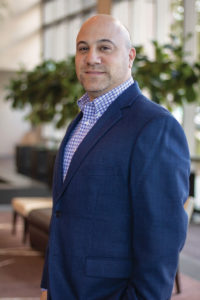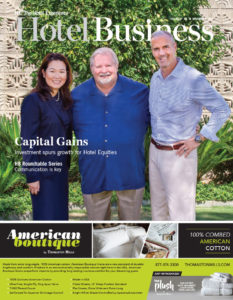 As the recently named brand president of Tryp by Wyndham, Anthony Emanuelo has been busy. Amid trips to the brand’s far-flung properties—from Fort Lauderdale, FL, to Xi’an, China—he’s plotting growth plans and developing a new brand prototype. Here, he gives Hotel Business the details.
As the recently named brand president of Tryp by Wyndham, Anthony Emanuelo has been busy. Amid trips to the brand’s far-flung properties—from Fort Lauderdale, FL, to Xi’an, China—he’s plotting growth plans and developing a new brand prototype. Here, he gives Hotel Business the details.
How are you settling into the new role? This role is a dream come true for me. I’m really passionate about the brand, and I’ve got a long history with it. I worked on the original integration when we acquired it from Meliá in 2010, so I got to spend a lot of my time going back and forth between Madrid and New Jersey, working with the Meliá team to understand the roots of the brand. And the whole time, we were creating the new lifestyle concept. We were able to learn a lot about the brand while instituting something new, and the result right in the beginning was a brand new Tryp, the first in North America, in New York City; that property is still with us to this day. There was a lot of cross-pollination between the two companies to get the concept there. I have a deep affection for Tryp.
How do you differentiate Tryp from other lifestyle brands? The lifestyle segment has a very long-term momentum. It’s definitely a trend here, but it’s more than a segment. It’s got to be authentic for the guests. This is what they expect when they travel.
This summer, I took a road trip to Boston with my son. It was his first trip to Boston. He loved the city, the energy of Boston—there’s a great, positive vibe, young feeling, the great historic nature of the city. One night, we get back to the hotel and were watching TV, and he said, “I love Boston, but every time we come back to the hotel, I feel we’re disconnected from the city.” For an 11-year-old to be that astute and understand what he wants is experiences, to feel the vibrancy and energy of the city, even when he’s in the hotel, and then the lack of that, he feels disconnected—that’s the way travel goes now.
What do you see as being your most immediate, short-term goals? The first couple of months, I spent a lot of time traveling to see the different hotels we have, trying to see the product and the hotels and how they envision what the brand is. I’ve seen 40 Tryp hotels over my years; just recently, I was in China, and I stayed in the Tryp in Xi’an, the first Tryp we’ve ever had in China—and what a great place to start Tryp. It was the birthplace of Chinese civilization, but it also has this new technology vibe to the city, so you get this fusion. The hotel has that historic nature to it in its design, but it also has cool amenities. There’s a rooftop basketball court. I spent one night shooting baskets with a colleague overlooking the city and all the lights there, sipping beer they brew in the lobby. It’s a great night where you get to relax at the hotel but still feel the energy of the city.
How would you describe your growth strategy for Tryp? We’ve got a couple of great properties coming in next year. We’ve got one in Coral Gables, which will be a complement to the portfolio we have in Florida, where we have Miami, Fort Lauderdale and St. Augustine. And we’ve got another property in Lawrenceville, a neighborhood in Pittsburgh that was named America’s coolest neighborhood. That hotel will be an adaptation of an old vocational school; it’ll incorporate all of those really cool aspects of the school, and bring world-class dining to the location as well.
The strategy we’re looking at is to be in key cities, key airport locations and college towns. I don’t believe lifestyle hotels have to be tethered to top markets. It’s great to be in those, but lifestyle is the way travelers want to experience a new city. My key is to work with owners that understand that concept, understand that the location they have has a great value to the guests that are coming there.
Looking at the current market, are you seeing more new-construction opportunities or conversions? Currently, we have almost all new-construction for Tryp. However, I want some conversion opportunities. I want about 70% new-construction and 30% conversions.
When I think about conversions, it’s not just hotels that can be converted to Tryp, although we want those as well. We want those historic buildings, those adaptive-reuses in those cities being reborn. We’re seeing that in Lawrenceville, we saw it with Newark, NJ—the hotel used to be a 1920s hotel, and they did a great job preserving a lot of the history—mosaic tiles, mural paintings in the ceilings, a lot of original woodwork. I get excited about those properties.
What are your long-term goals? The biggest strategy is to focus on development. Tryp is in 20 countries across the globe, it’s recognizable, it’s on all corners of the map, but I want to grow North America. For all of these travelers who come from international—and if you look at the statistics and all of the traveling being done from international, you’ve got quite a bit of folks coming here that want to go into different cities—we want the Tryp brand there for them, a brand they recognize.
What’s something about Tryp that people might be surprised to know? What’s kind of interesting for a lifestyle brand is the family rooms and fitness rooms. When people think lifestyle, they don’t think about families. It’s very different for Tryp. The family rooms are about 10% of our inventory that we do at each hotel, and those are usually the first rooms that sell out at the brand. You get a bit of a premium, but guests are able to stay in one room with bunk beds for the kids, instead of having to rent two rooms.
Looking toward the future, is there anything you’re experimenting with or thinking about to keep the Tryp by Wyndham brand fresh for guests? We’ve got the design and construction team working on a new prototype we’ll be able to roll out shortly. It’ll have an ode to the Mediterranean heritage of the brand because we never want to lose that—it is very much ingrained in the essence of the brand—but with some updates to keep design current. Under the original Tryp prototypes, we’re working at seven to eight years old. We’re really excited about this update. HB

